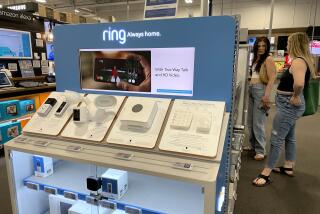THE GOODS : Home Economics : Good Try, but No Dice
- Share via
The picture telephone, the electric soup stirrer, the knife-fork, the biodegradable plastic dishes that dissolve in the kitchen sink, the talking refrigerator. . . . The path of consumer history is strewn with rejects.
Although the upcoming International Housewares Show in Chicago will unveil thousands of products, the ultimate test rests with American shoppers--who can unexpectedly balk.
When computer chip maker Intel reversed itself this month and pledged to replace about 4 million of its highly touted Pentium chips (their slight flaws shouldn’t bother ordinary consumers, Intel had maintained), it was proof once again that the customer is always right.
“Market research is not a science, it’s an art,” says industrial designer Cooper Woodring, longtime head of new products and design for JCPenney. “We’ve learned a lot of questions to get to the truth about what people want, but it isn’t foolproof.”
Some products have sunk with a mighty splash. Most consumers remember the public outrage in 1985 when Coca-Cola, with great fanfare, unveiled a new formula to replace its 99-year-old Coke. But the company’s about-face was so nimble that some competitors still wonder if Coca-Cola didn’t engineer the whole dispute just to get publicity.
Less fortunate was the Ford Motor Co. Not only did Ford lose nearly $350 million when consumers spurned its cutting-edge 1957 Edsel, the name has lingered as a symbol for marketplace rejection.
Other bombs fizzle quietly. The Susan B. Anthony dollar, a coin commemorating the 19th-Century Suffragette, was in circulation from 1979 to ‘81, but it looked so much like a quarter that it was dubbed the “Susan B. Ugly.” “When they tried to find out how it happened,” Woodring says, “nobody would take credit for designing it.”
Some bombs keep returning. When Bell Telephone introduced its Picturephone 20 years ago, customers said no thanks. Fifteen years later, Sony, Mitsubishi and Panasonic all introduced video phone models that went nowhere, even while consumers snapped up faxes, cellular phones and other technology. Now there is talk again of videophones on the Internet, despite compelling evidence that most people don’t want to be seen while they talk on the telephone.
Says Woodring: “When you do consumer research, people can tell you what they don’t like, but not what they want.”
Sometimes research can’t tell you anything, he adds, citing a case in point:
“Akio Morita, who recently retired as head of Sony Corp., was told by his consumer research department that the Walkman would be a bomb. Morita stuck to his conviction and made it anyway, and it almost changed the world.”
More to Read
Inside the business of entertainment
The Wide Shot brings you news, analysis and insights on everything from streaming wars to production — and what it all means for the future.
You may occasionally receive promotional content from the Los Angeles Times.










